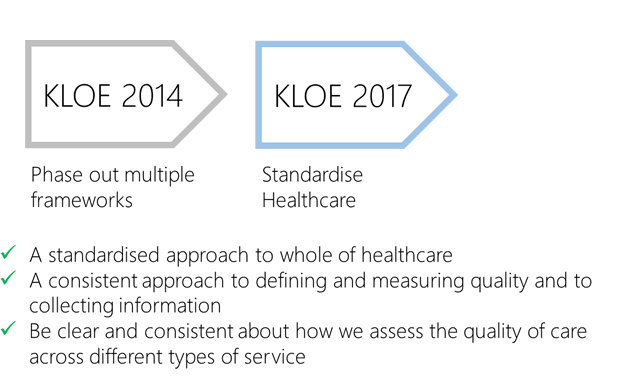11 Frameworks down to 2: What this means for you
For the first time, a standardised approach to whole of healthcare
What the CQC want to achieve is:-
- A consistent approach to defining and measuring quality and to collecting information.
- Be clear and consistent about how we assess the quality of care across different types of service.
Rating Characteristics:
A standardised framework with a standardised rating system could have been an immense leap forward in healthcare standards and trust in CQC inspections.
Unfortunately it has an Achilles Heel that undermines the concept of comparability of the rating system.
The inspection is not designed to achieve an objective, measurable and replicable audit. It is impossible for an individual provider or even an expert independent auditor to carry out a self-assessment using these documents, and guarantee that the inspector will also come to the same conclusions. The “measurements” are frequently subjective measures such as whether you have been innovative enough, or have set yourself apart from similar providers. So in theory, a provider could be ‘outstanding’ but as soon as all others achieve the same standard, you are automatically demoted to the ordinary ‘Good’ status.
As before, when it comes to the dividing lines between Good Vs Outstanding, to a large extent you are at the mercy of the inspector of the day.
Targeted Approach
CQC says “Safety continued to be our biggest concern across all sectors – often influenced by the quality of leadership” so they will be focusing on:-
- Safety: We have used the learning from our inspections to strengthen a number of elements of safety, including recruitment practices, safeguarding, discrimination, medicines management, information sharing and management, and responding to external alerts and reviews.
- Leadership (Well-led): In strengthening our assessment of well-led, we are clear that there is a demonstrable link between leadership, culture and the delivery of safe, high-quality care, and our focus on well-led is intended to support and reinforce this link.
Lighter touch PIR – but not for most of you
The document speaks of light touch Provider Information Requests, by not asking for policies and intelligence before the inspection visit, however, this entire chapter only applies to Acute Trusts, and not to the vast majority of providers out there.
The SIX Themes
The new KLOEs include 6 themes that the CQC have deemed necessary to improve on, based on their experiences. Effectively this is just a summary of which sections contain new KLOEs.
- System leadership, integration and information-sharing
- Information governance and data security
- Technology: For efficiency, accessibility and more person-centred
- Medicines: Basically medicine management
- End of life care: Delivering good quality care at the end of life
- Personalisation, social action and the use of volunteers
What else?
In their statements of principles about why the framework is being changed, the CQC emphasises their role in seeking improvements and will be looking for providers to “demonstrate how they are developing and adapting to new evidence of good practice as well as the changing care landscape to improve the quality of that care”
The emphasis here is that you will be asked to show continuous improvement.
YOU CAN DOWNLOAD KLOEs FROM THE TOOLKITS PAGE
